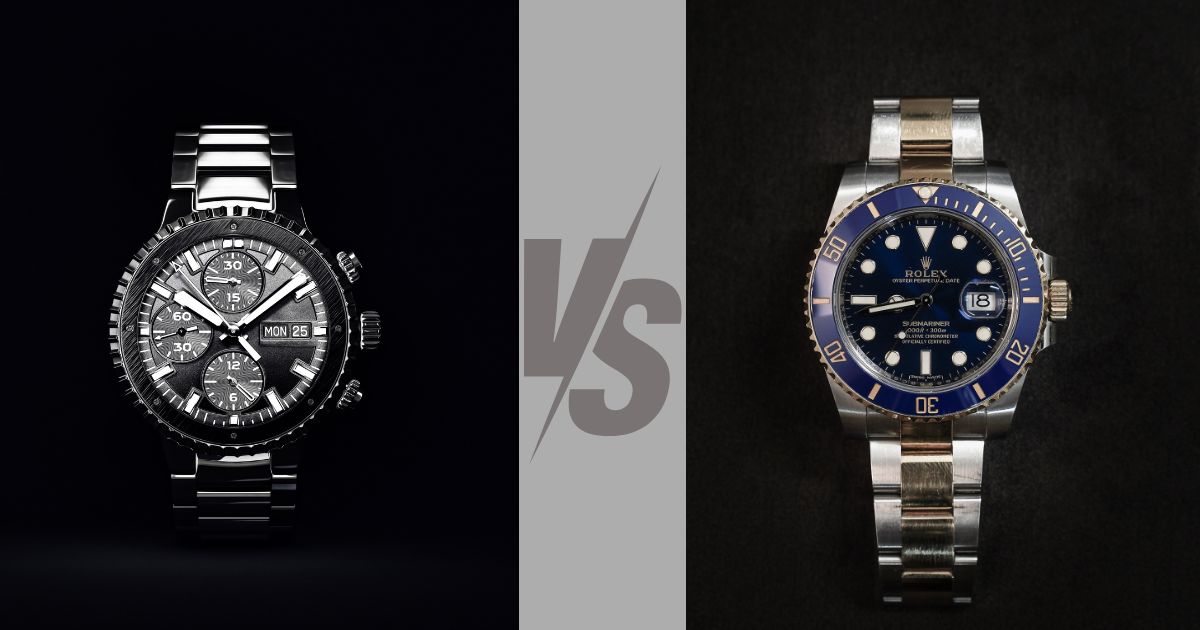Omega vs Rolex stand as two of the most iconic and respected watch brands in the world. For decades, these luxury timepieces have competed for the top spot in the hearts of watch enthusiasts. This article explores the key differences between Omega vs Rolex, examining their history, craftsmanship, technology, and much more. By the end, you’ll have a clearer understanding of which brand might suit your style and needs better.
The History of Omega vs Rolex
Omega’s journey began in 1848 when Louis Brandt founded the company in La Chaux-de-Fonds, Switzerland. Initially, the company produced pocket watches, but it quickly gained recognition for its precision and quality. Omega achieved fame for its role as the official timekeeper of the Olympic Games since 1932 and for being the first watch on the moon, worn by astronaut Buzz Aldrin during the Apollo 11 mission in 1969.
In contrast, Rolex’s history started in 1905 when Hans Wilsdorf and Alfred Davis founded the brand in London. Rolex focused on creating wristwatches, which were rare at the time. The company moved to Switzerland in 1919, where it developed some of its most iconic models. Rolex pioneered the first waterproof wristwatch, the Oyster, in 1926, and the first self-winding mechanism with a Perpetual rotor in 1931.
Both Omega vs Rolex have deep-rooted histories filled with innovation, making them giants in the luxury watch industry.
Design Philosophy: Omega vs Rolex
Omega’s design philosophy emphasizes innovation and modern aesthetics. The brand often incorporates cutting-edge materials and technology into its watches, resulting in a futuristic look. Omega’s designs cater to those who appreciate a blend of tradition and innovation. The Seamaster and Speedmaster collections, with their bold and dynamic designs, exemplify this philosophy.
Rolex, on the other hand, adheres to a more classic and timeless design philosophy. The brand focuses on creating watches that remain elegant and understated, regardless of changing trends. Rolex’s designs emphasize durability, precision, and luxury, making their watches suitable for any occasion. The Submariner and Datejust collections perfectly illustrate Rolex’s commitment to timeless design.
While Omega pushes the boundaries of watch design with modern aesthetics, Rolex remains faithful to its classic roots, ensuring its watches never go out of style.
Technology and Innovation: Omega vs Rolex
Omega stands at the forefront of watchmaking technology. The brand introduced the Co-Axial escapement in 1999, a revolutionary mechanism that reduces friction, enhances precision, and extends the watch’s lifespan. Omega also excels in anti-magnetic technology, with its Master Chronometer certification ensuring resistance to magnetic fields up to 15,000 gauss. The brand’s dedication to innovation is evident in every aspect of its watches, from movement to materials.
Rolex also boasts a history of technological innovation. The brand developed the first waterproof wristwatch, the Oyster, in 1926, and the Perpetual rotor, which revolutionized self-winding watches, in 1931. Rolex’s Parachrom hairspring, introduced in 2000, significantly improves shock resistance and precision. Although Rolex doesn’t introduce new technologies as frequently as Omega, the brand focuses on perfecting existing ones, ensuring reliability and durability.
Both Omega vs Rolex excel in technological innovation, but their approaches differ. Omega leads in pioneering new technologies, while Rolex perfects and refines its existing ones.
Movement: Omega vs Rolex
Omega produces both in-house and outsourced movements, with a focus on precision and durability. The brand’s Co-Axial movements, developed in collaboration with master watchmaker George Daniels, represent a significant advancement in watchmaking technology. Omega’s movements undergo rigorous testing to achieve the Master Chronometer certification, ensuring they meet the highest standards of accuracy and reliability.
Rolex exclusively produces in-house movements, which undergo meticulous testing and assembly. The brand’s movements are known for their robustness and precision, with each movement passing the Swiss Official Chronometer Testing Institute (COSC) certification. Rolex’s self-winding movements, such as the Caliber 3135, have set the standard for accuracy and reliability in the watch industry.
Both Omega vs Rolex produce exceptional movements, with Omega focusing on innovative mechanisms like the Co-Axial escapement and Rolex emphasizing precision and durability.
Collections and Models: Omega vs Rolex
Omega offers a diverse range of collections, each catering to different tastes and lifestyles. The Seamaster collection, famous for its association with James Bond, is ideal for those who love adventure and water sports. The Speedmaster collection, known as the “Moonwatch,” appeals to space enthusiasts and collectors. Omega also offers the Constellation and De Ville collections, which provide a more classic and elegant look.
Rolex’s collections focus on timeless designs and versatility. The Submariner, a favorite among divers, offers both functionality and style. The Datejust, one of Rolex’s most iconic models, represents sophistication and elegance. Rolex also offers the Explorer, designed for adventurers, and the Day-Date, known as the “President’s Watch,” worn by numerous world leaders.
While Omega provides a wider variety of collections to suit different lifestyles, Rolex focuses on creating versatile models that can be worn on any occasion.
Brand Ambassadors and Endorsements
Omega has a rich history of partnering with prominent figures in sports, entertainment, and space exploration. The brand has been the official timekeeper of the Olympic Games since 1932 and has had long-standing partnerships with NASA and the James Bond franchise. Omega’s brand ambassadors include famous names such as George Clooney, Nicole Kidman, and Michael Phelps, who embody the brand’s spirit of innovation and adventure.
Rolex also maintains high-profile endorsements and partnerships. The brand sponsors prestigious sporting events such as Wimbledon, the US Open, and Formula 1. Rolex’s brand ambassadors include tennis legend Roger Federer, golf superstar Tiger Woods, and filmmaker James Cameron. These partnerships reinforce Rolex’s image as a brand associated with success, achievement, and timeless elegance.
Both Omega vs Rolex effectively use endorsements to enhance their brand image, with Omega focusing on adventure and innovation, and Rolex on tradition and prestige.
Durability and Longevity: Omega vs Rolex
Omega watches are known for their durability and robustness, making them suitable for adventurous lifestyles. The brand’s Seamaster models, with their water resistance and anti-magnetic properties, are particularly popular among divers and explorers. Omega watches undergo rigorous testing to ensure they can withstand extreme conditions, from the depths of the ocean to the vacuum of space.
Rolex watches are equally renowned for their durability and longevity. The brand’s Oyster case, first introduced in 1926, provides exceptional water resistance and protection against dust and shocks. Rolex watches are built to last, with many vintage models still functioning perfectly after decades of use. The brand’s commitment to quality and precision ensures that its watches retain their performance and appearance over time.
Both Omega vs Rolex produce watches that can withstand the test of time, with Omega emphasizing technological durability and Rolex focusing on timeless design and craftsmanship.
Accuracy and Precision: Omega vs Rolex
Omega places a strong emphasis on accuracy and precision, with its watches undergoing rigorous testing to meet the Master Chronometer certification. This certification, which surpasses the COSC standard, ensures that Omega watches achieve exceptional accuracy even under extreme conditions. The brand’s Co-Axial escapement and anti-magnetic technology further enhance the precision of its timepieces.
Rolex also prioritizes accuracy, with all its movements certified by the COSC as chronometers. The brand’s focus on precision is evident in its meticulous attention to detail during the manufacturing process. Rolex’s Parachrom hairspring and Chronergy escapement significantly improve the accuracy and reliability of its watches, ensuring they perform consistently in any environment.
Both Omega vs Rolex excel in accuracy and precision, with Omega achieving Master Chronometer certification and Rolex maintaining its reputation for chronometer-certified movements.
Materials and Craftsmanship
Omega uses a combination of traditional craftsmanship and modern materials in its watches. The brand incorporates high-tech materials such as ceramic, titanium, and Liquidmetal in its designs, resulting in watches that are both durable and lightweight. Omega’s attention to detail is evident in the finishing and assembly of each timepiece, ensuring they meet the highest standards of quality.
Rolex is synonymous with traditional craftsmanship and the use of premium materials. The brand sources its own gold and produces its own alloys, ensuring consistent quality across its watches. Rolex’s watches are hand-assembled by skilled artisans, with each component meticulously crafted to meet the brand’s exacting standards. The use of precious metals like 18k gold and platinum further enhances the luxury and exclusivity of Rolex watches.
Both Omega vs Rolex demonstrate exceptional craftsmanship, with Omega combining modern materials and techniques, and Rolex emphasizing traditional craftsmanship and luxury.
Price Range: Omega vs Rolex
Omega watches generally range from $3,000 to $8,000, with some limited-edition models reaching higher prices. The brand offers a wide range of models at various price points, making it accessible to a broader audience. Omega’s watches provide excellent value for money, with a high level of craftsmanship and innovation at a relatively affordable price.
Rolex watches typically start at around $5,000 and can go up to several hundred thousand dollars for rare and limited-edition models. The brand’s watches are often more expensive than Omega’s, reflecting the prestige and exclusivity associated with the Rolex name. Rolex watches are also known to hold their value well over time, making them a popular choice among collectors.
When it comes to price, Omega offers a wider range of options to cater to different budgets, while Rolex is positioned as a more exclusive brand with higher price points reflecting its status.
Resale Value: Omega vs Rolex
Rolex watches command a higher resale value than Omega watches, often retaining or even appreciating over time. This is due to the brand’s strong reputation, limited production, and high demand. Rolex models like the Submariner and Daytona are particularly sought after in the second-hand market, with some vintage models fetching prices well above their original retail value.
Omega watches, while not as strong in resale value as Rolex, still hold their value relatively well. The brand’s limited-edition models and those with historical significance, such as the Speedmaster “Moonwatch,” tend to perform better in the resale market. However, Omega watches generally do not appreciate as significantly as Rolex watches.
When considering resale value, Rolex clearly has the edge over Omega, making it a more attractive option for those who view their watch purchase as an investment.
Collectibility: Omega vs Rolex
Rolex enjoys a higher level of collectibility due to its iconic status and limited production runs. Certain models, such as the Submariner, Daytona, and GMT-Master, have become highly sought after by collectors, with vintage models often fetching astronomical prices at auctions. Rolex’s ability to create timeless designs that remain relevant across generations adds to its appeal among collectors.
Omega also has a strong presence in the watch collecting community, particularly with its Speedmaster “Moonwatch.” The brand’s association with space exploration and its role in the Apollo missions have made the Speedmaster a highly collectible model. Omega’s limited-edition releases and collaborations with organizations like NASA further enhance its collectibility.
While both brands have a strong following among collectors, Rolex holds a slight advantage due to its iconic status and the rarity of certain models.
Popularity and Brand Recognition
Rolex stands as one of the most recognized luxury brands in the world, synonymous with success, prestige, and quality. The brand’s crown logo and name are instantly recognizable, making Rolex a symbol of status and achievement. Rolex’s widespread popularity is reflected in its strong presence in popular culture, with the brand frequently appearing in movies, music, and sports.
Omega also enjoys a high level of brand recognition, particularly among watch enthusiasts and those familiar with its history. The brand’s association with the Olympic Games, space exploration, and James Bond has helped Omega maintain a strong presence in the luxury watch market. While not as universally recognized as Rolex, Omega is still regarded as one of the top watch brands in the world.
Both Omega vs Rolex have achieved significant brand recognition, with Rolex having a slight edge due to its iconic status and cultural presence.
Warranty and Service: Omega vs Rolex
Omega offers a five-year warranty on all its watches, reflecting the brand’s confidence in the quality and durability of its timepieces. The brand also provides a comprehensive service network, with authorized service centers available worldwide. Omega recommends servicing its watches every five to eight years to maintain optimal performance.
Rolex also provides a five-year warranty on its watches, with the option to extend the warranty for an additional year when purchasing through authorized dealers. The brand’s service network is extensive, with service centers located in major cities around the world. Rolex recommends servicing its watches every ten years, although many owners choose to service them more frequently.
Both Omega vs Rolex offer excellent warranty and service options, ensuring that their watches remain in top condition for years to come.
Availability and Distribution: Omega vs Rolex
Omega watches are widely available through authorized dealers, boutiques, and online platforms. The brand’s extensive distribution network ensures that its watches are accessible to a global audience. Omega’s presence in major cities and luxury shopping destinations further enhances its availability.
Rolex watches, while also widely available, are often more difficult to obtain due to high demand and limited production. Certain models, such as the Submariner and Daytona, have long waiting lists, making them highly sought after. Rolex’s strategy of limited availability has only increased the brand’s desirability and exclusivity.
While Omega offers greater accessibility and availability, Rolex’s limited distribution adds to its allure and exclusivity.
Omega vs Rolex: Which One Is Right for You?
Choosing between Omega vs Rolex ultimately comes down to personal preference and priorities. If you value cutting-edge technology, modern design, and a wider range of models at various price points, Omega may be the better choice. The brand’s strong emphasis on innovation and its association with iconic moments in history make Omega a compelling option for those who appreciate both style and substance.
On the other hand, if you prioritize timeless design, prestige, and a strong investment potential, Rolex is the brand for you. Rolex’s iconic status, exceptional craftsmanship, and limited availability make it a symbol of success and achievement. Whether you’re looking for a watch that holds its value or one that can be passed down through generations, Rolex offers unparalleled appeal.
Ultimately, both Omega vs Rolex represent the pinnacle of watchmaking, and either brand will provide a timepiece that combines luxury, precision, and heritage.
Conclusion
In the world of luxury watches, Omega vs Rolex stand as titans, each with its own unique strengths and appeal. Omega impresses with its innovative technology, modern designs, and rich history of achievements, while Rolex captivates with its timeless elegance, precision craftsmanship, and prestigious reputation.
Whether you choose Omega or Rolex, you’re not just purchasing a watch; you’re investing in a piece of history, craftsmanship, and artistry. These brands have earned their place at the top of the watchmaking world, and owning one is a testament to your appreciation for quality, style, and heritage.
Choosing between Omega vs Rolex is not just about picking a watch; it’s about embracing a legacy, a lifestyle, and a symbol of excellence. Whichever brand you choose, you can be confident that you’re making a decision that will bring you joy and pride for years to come.










